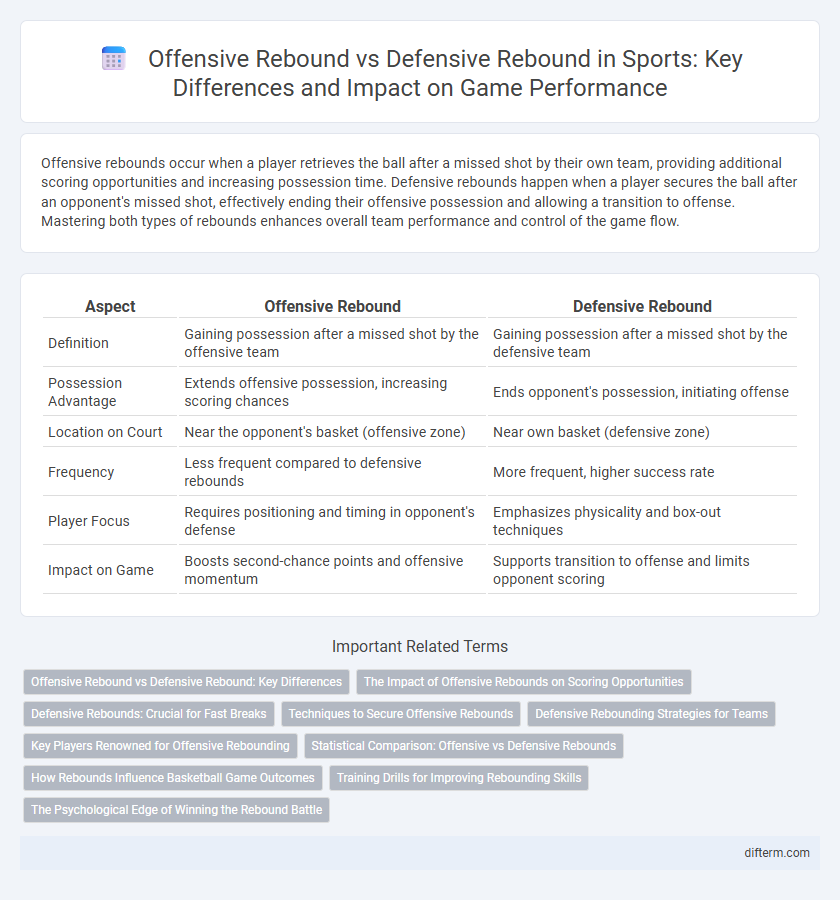Offensive rebounds occur when a player retrieves the ball after a missed shot by their own team, providing additional scoring opportunities and increasing possession time. Defensive rebounds happen when a player secures the ball after an opponent's missed shot, effectively ending their offensive possession and allowing a transition to offense. Mastering both types of rebounds enhances overall team performance and control of the game flow.
Table of Comparison
| Aspect | Offensive Rebound | Defensive Rebound |
|---|---|---|
| Definition | Gaining possession after a missed shot by the offensive team | Gaining possession after a missed shot by the defensive team |
| Possession Advantage | Extends offensive possession, increasing scoring chances | Ends opponent's possession, initiating offense |
| Location on Court | Near the opponent's basket (offensive zone) | Near own basket (defensive zone) |
| Frequency | Less frequent compared to defensive rebounds | More frequent, higher success rate |
| Player Focus | Requires positioning and timing in opponent's defense | Emphasizes physicality and box-out techniques |
| Impact on Game | Boosts second-chance points and offensive momentum | Supports transition to offense and limits opponent scoring |
Offensive Rebound vs Defensive Rebound: Key Differences
Offensive rebounds occur when a player retrieves the ball after a missed shot by their own team, providing an additional opportunity to score and maintain possession. Defensive rebounds, on the other hand, happen when a player secures the ball following an opponent's missed shot, often leading to a transition from defense to offense. The key difference lies in their strategic impact: offensive rebounds extend offensive plays, while defensive rebounds initiate defensive stops and fast breaks.
The Impact of Offensive Rebounds on Scoring Opportunities
Offensive rebounds significantly increase a team's scoring opportunities by providing additional chances to shoot and maintain ball possession in the opponent's half. Studies show teams securing more offensive rebounds typically have higher second-chance points, directly contributing to overall scoring efficiency. The ability to capitalize on offensive rebounds often separates high-scoring teams from their competitors in fast-paced basketball games.
Defensive Rebounds: Crucial for Fast Breaks
Defensive rebounds secure possession after the opposition misses a shot, enabling quick transitions to fast breaks and scoring opportunities. Players who excel in defensive rebounding disrupt opponents' second-chance points while initiating rapid offensive plays. Teams with high defensive rebound rates often dominate fast break points, enhancing overall game control and momentum.
Techniques to Secure Offensive Rebounds
Mastering offensive rebounding techniques begins with aggressive positioning and relentless anticipation of missed shots. Players utilize quick footwork and strong box-out skills to gain leverage against defenders, enhancing control over the ball's bounce. Explosive vertical jumps paired with sharp hand-eye coordination significantly increase the chances of securing second-chance points in high-pressure game situations.
Defensive Rebounding Strategies for Teams
Effective defensive rebounding strategies rely on positioning, communication, and anticipation to secure possession and prevent second-chance points. Teams utilize techniques like boxing out opponents, prioritizing aggressive box-outs, and maintaining spatial awareness to dominate the defensive glass. Successful defensive rebounding directly limits offensive opportunities, increases transition chances, and strengthens overall team defense.
Key Players Renowned for Offensive Rebounding
Dominate the court with players like Dennis Rodman, Charles Barkley, and Kevin Love, who excel in offensive rebounding through relentless positioning and timing. Offensive rebounds create second-chance opportunities, crucial for boosting a team's scoring potential and momentum during tight games. These athletes combine strength, anticipation, and agility to outmaneuver defenders and secure critical possession under the basket.
Statistical Comparison: Offensive vs Defensive Rebounds
Defensive rebounds statistically occur more frequently than offensive rebounds, accounting for approximately 75-80% of total rebounds in professional basketball games due to the defensive team's positioning advantage. Offensive rebounds, though less common, contribute significantly to second-chance scoring opportunities, often increasing a team's offensive efficiency by around 5-7%. Players specializing in offensive rebounding typically average 3-5 offensive rebounds per game, while elite defensive rebounders can secure 8-12 defensive rebounds each game.
How Rebounds Influence Basketball Game Outcomes
Offensive rebounds extend possessions and increase scoring opportunities by allowing teams to maintain ball control after missed shots, often leading to higher point totals. Defensive rebounds are crucial for limiting opponents' second-chance points and initiating fast breaks, effectively shifting momentum in a game. Teams that dominate the rebounding battle, particularly in offensive rebounds, tend to control the pace and ultimately secure more victories.
Training Drills for Improving Rebounding Skills
Training drills for improving rebounding skills focus on building physical strength, timing, and positioning to excel in both offensive and defensive rebounds. Box-out drills develop the ability to maintain position against opponents, while tip drills enhance hand-eye coordination and quick reflexes necessary for securing offensive boards. Consistent practice of explosive jump exercises and reaction drills ensures players maximize their effectiveness in securing rebounds under pressure.
The Psychological Edge of Winning the Rebound Battle
Offensive rebounds provide teams with a critical psychological boost, signaling relentless effort and increasing scoring opportunities, while defensive rebounds reinforce control and momentum by denying opponents second-chance points. Securing rebounds under pressure elevates team morale and creates a tangible sense of dominance on the court. Mastery in the rebound battle often shifts the game's emotional dynamics, contributing significantly to a team's overall confidence and composure.
offensive rebound vs defensive rebound Infographic

 difterm.com
difterm.com